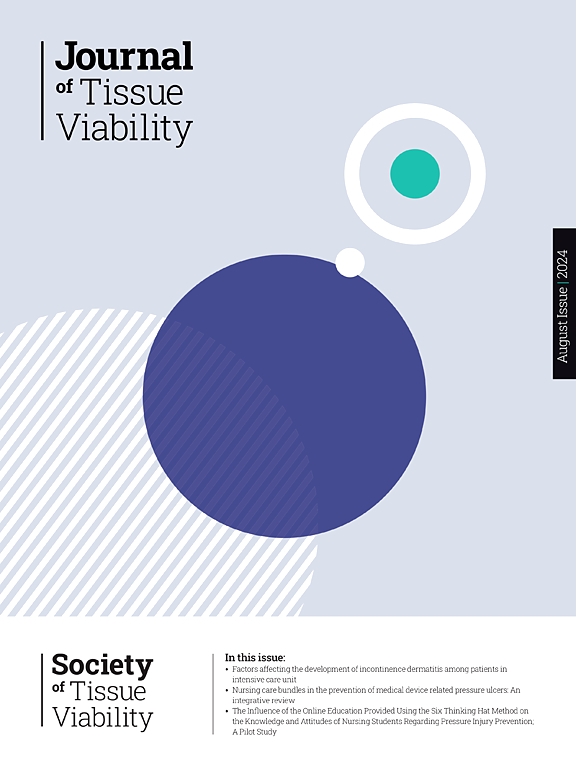Synthesising the evidence for patient and public involvement in pressure ulcer research: A scoping review protocol
IF 2.4
3区 医学
Q2 DERMATOLOGY
引用次数: 0
Abstract
Introduction
There is a growing shift toward greater inclusion of patients and the public in the design, conduct, and implementation of research to ensure it is more meaningful, relevant and impactful. This involvement creates a partnership in which patients and the public contribute to decisions throughout the research lifecycle. While the impact and importance of patient and public involvement (PPI) in research is becoming increasingly recognised, the extent of PPI in pressure ulcer (PU) research has yet to be fully established. This scoping review aims to provide insights into how PPI has been included and reported in PU research, ultimately placing a spotlight on the impact and importance of reporting PPI to guide future PU research.
Methods and analysis
Through synthesising literature from a diverse global landscape, this scoping review aims to achieve the following objectives (1) To explore and map the stage(s) of the PU research cycle where PPI has been incorporated (2) To identify and describe the range of participatory methods, including frameworks, guidelines, or tools, that have been used to facilitate the involvement of patients and the public in PU research. (3) To identify and synthesise reporting impacts of including PPI in PU research, and (4) To map and analyse the terminology commonly used to describe PPI in PU research.
The Joanna Briggs Institute scoping review methodology and the Preferred Reporting Items for Systematic Reviews and Meta-Analyses extension for scoping reviews framework will guide the conduct and reporting of this review. Nine databases will be included in the search strategy and all articles will be independently screened for eligibility by two authors. Data from eligible articles will be extracted using a pre-defined data extraction table, and the results will be analysed and synthesised using the PAGER (Patterns, Advances, Gaps, Evidence for practice and Research recommendations) framework.
Ethics and dissemination
Ethics approval will not be required considering the nature of this scoping review. PPI advisory partners will be consulted for disseminating the results in a format that is accessible and understood by a layperson, in order to communicate the findings to a wide audience and diverse communities. This scoping review will be published in a peer reviewed journal and results will be disseminated at local national and international conferences.
Registration
This scoping review is registered on the Open Science Framework (https://doi.org/10.17605/OSF.IO/JHT34). As is typical with scoping reviews, this protocol may evolve over time. Any updates will be documented on the Open Science Framework platform, along with a clear rationale for the changes.
综合患者和公众参与压疮研究的证据:范围审查方案
在研究的设计、实施和实施过程中,越来越多的患者和公众参与进来,以确保研究更有意义、更相关、更有影响力。这种参与创造了一种伙伴关系,患者和公众在整个研究生命周期中为决策做出贡献。虽然患者和公众参与(PPI)在研究中的影响和重要性日益得到认可,但PPI在压疮(PU)研究中的程度尚未完全确定。本综述旨在深入了解PPI在PU研究中是如何被纳入和报告的,最终将重点放在报告PPI的影响和重要性上,以指导未来的PU研究。方法和分析通过综合来自不同全球景观的文献,本范围综述旨在实现以下目标:(1)探索和绘制纳入PPI的PU研究周期的阶段(2)确定和描述用于促进患者和公众参与PU研究的参与性方法的范围,包括框架,指南或工具。(3)识别和综合将PPI纳入PU研究的报告影响,以及(4)绘制和分析用于描述PU研究中PPI的常用术语。乔安娜布里格斯研究所的范围审查方法以及范围审查框架的系统审查和元分析扩展的首选报告项目将指导本审查的实施和报告。9个数据库将被纳入搜索策略,所有文章将由两位作者独立筛选是否合格。将使用预定义的数据提取表从符合条件的文章中提取数据,并使用PAGER(模式、进展、差距、实践证据和研究建议)框架对结果进行分析和综合。伦理和传播考虑到此范围审查的性质,不需要伦理批准。为了将调查结果传达给广泛的受众和不同的社区,将与PPI咨询合作伙伴协商,以一种外行人可以获得和理解的格式传播结果。这项范围审查将发表在同行评议的期刊上,结果将在地方、国家和国际会议上传播。此范围审查已在开放科学框架(https://doi.org/10.17605/OSF.IO/JHT34)上注册。正如典型的范围界定审查一样,该协议可能会随着时间的推移而发展。任何更新都将在开放科学框架平台上进行记录,并提供明确的更改理由。
本文章由计算机程序翻译,如有差异,请以英文原文为准。
求助全文
约1分钟内获得全文
求助全文
来源期刊

Journal of tissue viability
DERMATOLOGY-NURSING
CiteScore
3.80
自引率
16.00%
发文量
110
审稿时长
>12 weeks
期刊介绍:
The Journal of Tissue Viability is the official publication of the Tissue Viability Society and is a quarterly journal concerned with all aspects of the occurrence and treatment of wounds, ulcers and pressure sores including patient care, pain, nutrition, wound healing, research, prevention, mobility, social problems and management.
The Journal particularly encourages papers covering skin and skin wounds but will consider articles that discuss injury in any tissue. Articles that stress the multi-professional nature of tissue viability are especially welcome. We seek to encourage new authors as well as well-established contributors to the field - one aim of the journal is to enable all participants in tissue viability to share information with colleagues.
 求助内容:
求助内容: 应助结果提醒方式:
应助结果提醒方式:


